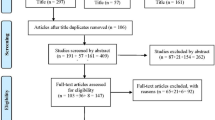Abstract
Students sometimes misunderstand or misinterpret scientific content because of persistent misconceptions that need to be overcome by science education—a learning process typically called conceptual change. The acquisition of scientific content matter thus requires a transformation of the initial knowledge-state of a common-sense picture of the world to an outcome state of a scientific conception articulated with scientific concepts, which the learner did not possess prior to learning. This paper introduces a taxonomy based on the idea that multiple operational criteria are needed to evaluate conceptual change into scientific concepts. Three sets of criteria—qualitative, quantitative and experimental—are identified, and their interrelations in the process of conceptual change are explored.
Similar content being viewed by others
Notes
References
Baxter, J. (1989). Children’s understanding of familiar astronomical events. International Journal of Science Education, 11(Special Issue), 502–513.
Biggs, J. (2003). Teaching for quality learning at university (2nd ed.). The Society for Research into Higher Education and Open University Press: Buckingham.
Bowden, J., Dall’Alba, G., Martin, E., Laurillard, D., Marton, F., Masters, G., et al. (1992). Displacement, velocity, and fames of reference: Phenomenographic studies of students’ understanding and some implications for teaching and assessment. American Journal of Physics, 60(3), 262–269.
Brown, D. E., & Clement, J. (1989). Overcoming misconceptions via analogical reasoning: Abstract transfer versus explanatory model construction. Instructional Science, 18, 237–261.
Carey, S. (1985). Conceptual change in childhood. Cambridge, MA: MIT Press.
Chi, M. (1992). Conceptual change within and across ontological categories: Examples from learning an discovery in science. In R. Giere (Ed.), Cognitive models of science. Minneapolis, MN: University of Minnesota Press.
Chi, M., Feltovich, P., & Glaser, R. (1981). Categorization and representation of physics problems by experts and novices. Cognitive Science, 5, 121–152.
Chi, M., & Slotta, J. (1993). The ontological coherence of intuitive physics. Cognition & Instruction, 10(2 & 3), 249–260.
Chi, M. T. H., Slotta, J., & DeLeeuw, N. (1994). From things to process: A theory of conceptual change for learning science concepts. Learning and Instruction, 4(1), 27–43.
DiSessa, A. A. (1988). Knowledge in pieces. In G. Forman & P. Pufall (Eds.), Constructivism in the computer age (pp. 49–70). Hillsdale, NJ: Erlbaum.
DiSessa, A. A. (1993). Toward an epistemology of physics. Cognition and Instruction, 10(2 & 3), 105–225.
DiSessa, A. A., Gillespie, N. M., & Esterly, J. M. (2004). Coherence versus fragmentation in the development of the concept of force. Cognitive Science, 28, 843–900.
Feynman, R., & Leighton, R. (1985). Surely you’re joking, Mr. Feynman!: Adventures of a curious character (p. 212ff). W. W. Norton.
Galilei, G. (1923/1957). The assayer. In S. Drake (Ed.), Discoveries and opinions of Galileo. New York: Anchor Books.
Hestenes, D., Wells, M., & Swackhamer, G. (1992). Force concept inventory. The Physics Teacher, 30(March 1992), 141–158.
Hewson, P. (1984). A conceptual change approach to learning science. European Journal of Science Education, 3, 383–396.
Karpicke, J. D. (2008). The critical importance of retrieval for learning. Science, 319, 966–968.
Kim, E., & Pak, S. (2002). Students do not overcome conceptual difficulties after solving 1000 traditional problems. American Journal of Physics, 70(7), 759–765.
Kuhn, T. (1970). The structure of scientific revolutions (2nd ed.). Chicago: University of Chicago Press.
Larkin, J. H. (1983). The role of problem representation in physics. In D. Gentner & A. N. Stevens (Eds.), Mental models (pp. 75–98). Hillsdale, NJ: Erlbaum.
Larkin, J., McDermott, J., Simon, D. P., & Simon, H. A. (1980). Expert and novice performance in solving physics problems. Science, 208, 1335–1342.
McCloskey, M. (1983). Naive theories of motion. In D. Gentner & A. N. Stevens (Eds.), Mental models (pp. 299–324). Hillsdale, NJ: Erlbaum.
Piaget, J. (1998). De la pédagogie. Paris: Odile Jakob.
Posner, G. J., Strike, K. A., Hewson, P. W., & Gertzog, W. A. (1982). Accommodation of a scientific conception: Toward a theory of conceptual change. Science Education, 66, 211–227.
Reif, F. (1987). Interpretation of scientific or mathematical concepts: Cognitive issues and instructional implications. Cognitive Science, 11, 395–416.
Slotta, J. D., Chi, M. T. H., & Joram, E. (1995). Assessing students misclassifications of physics concepts: An ontological basis for conceptual change. Cognition and Instruction, 13(3), 373–400.
Spelke, E., & Kinzler, K. (2007). Core knowledge. Developmental Science, 10(1), 89–96.
Strike, K. A., & Posner, G. J. (1982). Conceptual change and science teaching. European Journal of Science Education, 4(3), 231–240.
Vosniadou, S. (Ed.). (2008a). International handbook of research on conceptual change. New York: Routledge.
Vosniadou, S. (2008b). Conceptual change research: An introduction. In S. Vosniadou (Ed.), International handbook of research on conceptual change (pp. xiii–xxviii). New York: Routledge.
Vosniadou, S., & Brewer, W. F. (1992). Mental models of the earth: A study of conceptual change in childhood. Cognitive Psychology, 24, 535–585.
Wittgenstein, L. (1953) Philosophical Investigations. In G. E. M. Anscombe & R. Rhees (Eds.), (G. E. M. Anscombe, Trans.). Oxford: Blackwell.
Author information
Authors and Affiliations
Corresponding author
Rights and permissions
About this article
Cite this article
Lappi, O. Qualitative Quantitative and Experimental Concept Possession, Criteria for Identifying Conceptual Change in Science Education. Sci & Educ 22, 1347–1359 (2013). https://doi.org/10.1007/s11191-012-9459-3
Published:
Issue Date:
DOI: https://doi.org/10.1007/s11191-012-9459-3




